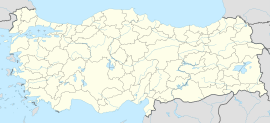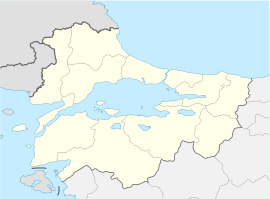Karabiga
Karabiga | |
|---|---|
| Coordinates: 40°24′13″N 27°18′14″E / 40.40361°N 27.30389°E | |
| Country | Turkey |
| Province | Çanakkale |
| District | Biga |
| Elevation | 16 m (52 ft) |
| Population (2021)[1] | 2,962 |
| Time zone | UTC+3 (TRT) |
Karabiga[2] (Karabuga[3]) is a town (belde) in the Biga District, Çanakkale Province, Turkey.[4] Its population is 2,962 (2021).[1] It is located at the mouth of the Biga River, on a small east-facing bay, known as Karabiga Bay.[5] Its ancient name was Priapus or Priapos (Ancient Greek: Πρίαπος).[6]
History
[edit]Originally a town of ancient Mysia, it was a colony of Miletus or of Cyzicus.[7] It had a good harbour. Strabo mentions that the area produced fine wine and that the god Priapus gave the town its ancient name.[8] Thucydides mentions the town as a naval station.[9] Arrian reports that in 334 BCE Alexander the Great sent Panegorus to take possession of the city and the city surrendered without contest, prior to the Battle of Granicus.[8][10] Besides the aforementioned authors, the town was noted by numerous ancient writers and geographers including Pomponius Mela,[11] Pliny the Elder,[12] Stephanus of Byzantium,[13] and the Geographer of Ravenna.[14]
Under the Eastern Roman Empire, the town was known as Pegae or Pegai (Πηγαί)[15] and was the site of a Byzantine fortress.[16]
During the Allied occupation following World War I, Karabiga was part of the lands that were claimed by Anzavur Ahmed Pasha in his attempt to keep the area from the Turkish nationalists. He was killed just outside Karabiga in April 1921 by Turkish nationalists aligned with Arnavud Rahman.[17]
References
[edit]- ^ a b "Address-based population registration system (ADNKS) results dated 31 December 2021" (XLS) (in Turkish). TÜİK. Retrieved 1 March 2023.
- ^ Karabiğa (Approved) at GEOnet Names Server, United States National Geospatial-Intelligence Agency
- ^ Karabuga (Variant) at GEOnet Names Server, United States National Geospatial-Intelligence Agency
- ^ Belde Belediyesi, Turkey Civil Administration Departments Inventory. Retrieved 1 March 2023.
- ^ Karabiğa Limanı (Approved) at GEOnet Names Server, United States National Geospatial-Intelligence Agency
- ^ Priapus (Variant) at GEOnet Names Server, United States National Geospatial-Intelligence Agency
- ^
 One or more of the preceding sentences incorporates text from a publication now in the public domain: Smith, William, ed. (1854–1857). "Priapus". Dictionary of Greek and Roman Geography. London: John Murray.
One or more of the preceding sentences incorporates text from a publication now in the public domain: Smith, William, ed. (1854–1857). "Priapus". Dictionary of Greek and Roman Geography. London: John Murray.
- ^ a b Strabo. Geographica. Vol. xiii. p. 587. Page numbers refer to those of Isaac Casaubon's edition.
- ^ Thucydides. History of the Peloponnesian War. Vol. 8.107.
- ^ Arrian Campaigns of Alexander I, 13
- ^ Pomponius Mela. De situ orbis. Vol. 1.19.
- ^ Pliny. Naturalis Historia. Vol. 4.24, 5.40.
- ^ Stephanus of Byzantium. Ethnica. Vol. s.v. Πρίαπος.
- ^ Ravenna Cosmography 2.18.
- ^ Norwich, John Julius (2006) The Middle Sea: A History of the Mediterranean Doubleday, New York, page 103, ISBN 978-0-385-51023-3
- ^ Setton, Kenneth M.; Hazard, Harry W. and Zacour, Norman P. (1980) A History of the Crusades: The Impact of the Crusades on Europe University of Wisconsin Press, Madison, Wisconsin, page 241, ISBN 978-0-299-10744-4
- ^ Gingeras, Ryan (2009) Sorrowful Shores: Violence, ethnicity, and the end of the Ottoman Empire, 1912-1923 Oxford University Press, Oxford, England, pages 106 and 118, ISBN 978-0-19-956152-0


